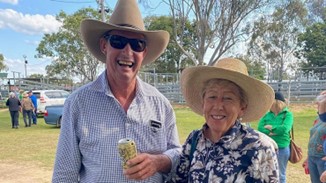Producer consultation spurs research into action
Here we chat with MLA’s Project Manager – Sheep and Goat Productivity, Daniel Forwood, about the producer consultation process which underpins MLA's research and adoption priorities. Read on to get up-to-speed on the latest research priorities which were presented recently in Sydney at the Red Meat Panel meeting. Also included is a case study snapshot, detailing how Queensland beef producers Herb and Sue George have seen positive flow-on effects from implementing pain relief on-farm – a clear example of how investment in producer-led research priorities has come to fruition.
Q&A with MLA’s Project Manager – Sheep and Goat Productivity, Daniel Forwood

How useful is it to have interactions with producers to develop their ideas and issues into research questions and Terms of Reference?
Producers are vital to our core business and their ideas shape our research, development and adoption (RD&A) programs across MLA. The consultation process is a great avenue for face-to-face engagement with producers. Without our producers’ priorities, we wouldn’t be able to deliver RD&A activities that improve on-farm productivity and profitability to the extent that we do. Producer feedback across the consultation process is incredibly important as their first-hand experience, knowledge of the land, and insights into industry issues aid the design of our research questions and subsequent development of Terms of References for RD&A projects.
How do you use the information that is collected?
During the consultation process, the information that’s collected from our face-to-face interactions with producers are presented as priorities, then translated into research questions which are informed by producer feedback. This feedback shapes the design of the Terms of References, which are subsequently reviewed by our producer representatives prior to going out for tender. Producers are included throughout the entire RD&A project pipeline and make the final decision on prospective RD&A projects and service providers.
What is the biggest challenge in meeting producers’ needs and priorities?
One of the biggest challenges, and consequently, opportunities, we encounter is that the demand for research is larger than our R&D levy income permits. There are so many issues that producers face across Australia, and ideally, every research question posed to MLA would be answered. However, we’re all operating in a challenging domestic and international economic environment, where costs are rising across the board. Seeking the opportunity in the challenge, the RD&A team at MLA has become more strategic with spending to ensure that we can stretch the levy dollar as far as possible. Setting the RD&A priorities in a biennial cycle for sheep and cattle and annually for goats, ensures that we can space investments accordingly with available funds to ensure we can do as many activities as possible to benefit producers.
MLA’s producer consultation process explainerWhy does MLA conduct producer consultation? MLA’s producer consultation process empowers grassfed beef and sheepmeat producers to directly influence the on-farm research, development and adoption (RD&A) activities their levies are invested in. This process ensures national and regionally relevant RD&A priorities are identified to deliver optimum value to producers. How does MLA conduct consultation around its RD&A investments? MLA conducts formal consultation with grassfed beef and sheepmeat producers every two years through facilitated workshops and discussions with Research Advisory Councils, culminating in a national workshop with regional producer chairs, Research Councils and key stakeholders to determine investment priorities. The steps taken during the consultation process include:
Who can get involved in the consultation process? Interested producers can submit their application to join their local regional consultation committee to ensure their priorities are put forward. In this way, producers are empowered to directly influence the on-farm RD&A activities their levies are invested in. To find your local committee, get in touch with the relevant council for your region:
This process ensures national and regionally relevant RD&A priorities are identified to deliver optimum value to producers. Otherwise, producers can attend as a guest or feed their idea through an existing member. How much has MLA invested in producer-identified projects? As a result of the producer consultation process, MLA has funded more than $50 million worth of projects that find solutions to producer priorities. The Producer Investment Call process has attracted more than 600 submitted preliminary proposals from 83 different applicant organisations over its lifespan. This consultation has resulted in close to 70 contracted projects. |
Research priorities identifiedSourced from around Australia via SALRC, NABRC and WALRC, the following key research priorities were presented at the recent Red Meat Panel meeting in Sydney. A selection of these priorities aimed to be developed into Terms of Reference over the next 12–18 months. Beef productivity:
Sheep productivity:
Sustainable feedbase:
Sustainability:
Animal wellbeing:
|
Research in action
Herb and Sue George operate a beef breeding operation in Jundah, Queensland. The impact of pain relief on productivity and wellbeing was a research priority sourced from MLA’s regional consultation process. Here we see a snapshot of how this research has had positive impacts on Herb and Sue George’s beef breeding operation, ‘Glen Valley’, in Jundah, Queensland. Case study: Pain relief delivers multiple benefits Implementing across-the-board pain relief to routine animal husbandry procedures has improved welfare, safety and efficiency on Herb and Sue George’s Queensland Channel Country property. Their beef breeding operation has stood the test of time under five generations of the family, through their commitment to ongoing learning, innovation and astute responsiveness to shifts in consumer expectations, including those around animal welfare. Their strategic approach to providing pain relief on-farm has improved wellbeing, with flow-on benefits including:
Read the full case study: Pain relief delivers multiple benefits |




